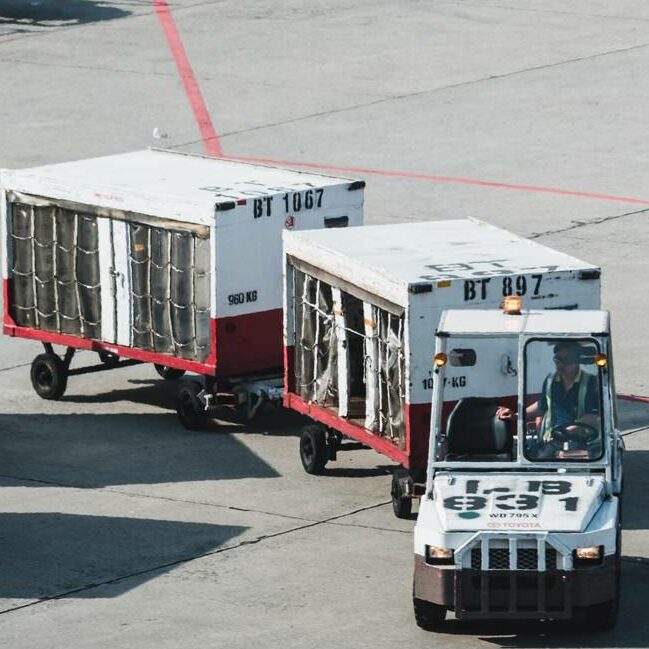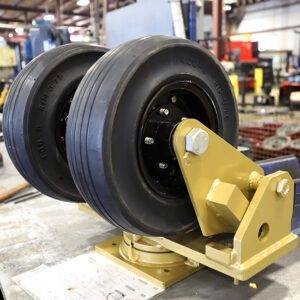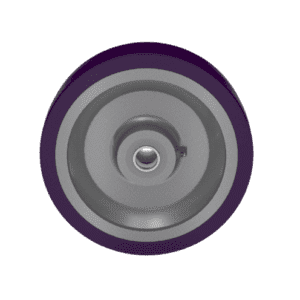

Caster wheels play a crucial role in various industries, providing mobility and manoeuvrability to various equipment. While caster wheels excel in many applications, high-speed environments present unique challenges that require careful consideration. Let’s look at the challenges associated with high-speed applications for caster wheels and discuss potential solutions to overcome them.
When a caster wheel rolls, its tire material undergoes compression as it touches the floor or surface. This compression causes the tire material to deform, storing potential energy. As the wheel rolls and moves forward, the deformed tire material gradually returns to its original shape.
During this recovery process, some stored energy is heat dissipation due to internal friction. This dissipation of energy is known as hysteresis loss. Over time, repeated cycles of deformation and recovery during wheel rotation can lead to a cumulative effect, resulting in decreased overall performance and efficiency of the caster wheel. And ultimately, leading to its failure. While friction between the tire and the surface certainly plays a role in caster wheel performance, the hysteresis loss primarily contributes to failure.
Selecting caster wheels designed for high-speed applications is essential to mitigate hysteresis-related failure in caster wheels. Wheels made from high-temperature nylon or polyurethane with low rolling resistance can help minimize friction and dissipate heat more effectively.
RELATED: The predominant mechanism leading to bond failure on casters is excessive heat.
 Let’s compare hysteresis and failure considerations between different caster wheel materials, including solid rubber and pneumatic (air-filled) rubber wheels. Solid rubber wheels are commonly used in various applications due to their durability and puncture resistance. When it comes to hysteresis,
Let’s compare hysteresis and failure considerations between different caster wheel materials, including solid rubber and pneumatic (air-filled) rubber wheels. Solid rubber wheels are commonly used in various applications due to their durability and puncture resistance. When it comes to hysteresis,
solid rubber wheels tend to exhibit higher levels of hysteresis loss than other materials.
Due to their composition, solid rubber wheels have a relatively high rolling resistance coefficient. This means that a significant amount of energy is lost as heat during the deformation and recovery process as the wheel rolls. This hysteresis loss increases rolling resistance, leading to higher energy consumption and reduced efficiency.
In terms of failure, solid rubber wheels can suffer from wear over time, especially when subjected to heavy loads or rough surfaces. The repeated cycles of deformation and recovery during rolling, combined with the accumulation of hysteresis loss, can cause the rubber to degrade and eventually lead to the tire’s cracking, chunking, or flattening. Solid rubber wheels may also be prone to flat spotting when left stationary for extended periods.
Pneumatic rubber wheels are typically air-filled, providing cushioning and shock absorption capabilities. Compared to solid rubber wheels, they tend to exhibit lower levels of hysteresis loss.
The air-filled design of pneumatic wheels allows them to deform and compress under load, absorbing shocks and vibrations. This deformation process involves lower energy dissipation than the more rigid solid rubber wheels, reducing hysteresis loss and potentially better rolling efficiency. However, pneumatic wheels are not without their failure considerations. They are more susceptible to punctures or leaks, which can lead to loss of air pressure and reduced performance.
Overinflation or underinflation can also affect the wheel’s performance and increase the risk of failure. Additionally, pneumatic wheels may require regular maintenance, such as monitoring and adjusting air pressure, to ensure optimal performance and prevent potential failures.
When selecting caster wheel materials, it’s essential to consider the specific application, load requirements, surface conditions, and environmental factors. Solid rubber wheels may be suitable for applications where durability and puncture resistance are crucial, while pneumatic tires are often preferred for applications requiring shock absorption and a smoother ride. Balancing hysteresis characteristics, failure considerations, and performance requirements can help choose the most appropriate caster wheel material for a given application.
At higher speeds, stability and vibration become critical factors. Caster wheels may experience vibrations, which can compromise the overall performance and manoeuvrability of the equipment. Instability can lead to erratic movement, reduced control, and safety hazards. Choosing caster wheels with precision bearings designed for high-speed applications can help minimize vibrations and ensure smoother operation. Additionally, consider caster wheels with shock-absorbing features or vibration-dampening mechanisms that can enhance stability and reduce the impact of uneven surfaces or sudden movements.

92A HPPT Polyurethane Tread
High-speed applications often involve transporting heavy loads or encountering dynamic forces. Caster wheels must withstand these demanding conditions without compromising load capacity or durability. Opting for caster wheels with reinforced frames, heavy-duty materials, and robust construction can enhance load capacity and extend the lifespan of the wheels. For example, our 92A HPPT Polyurethane Tread is a high-performance polyurethane formulation ideal for dynamic applications. HPPT resists heat buildup and can carry higher weight capacities, making it ideal for AGVs, Tuggers, and other higher-speed, higher-weight applications.
In high-speed applications, precise manoeuvrability is essential to navigate tight spaces or quickly change directions. Caster Concepts offers diverse casters with features like swivel on swivel tailored for engineers seeking advanced functionality.
If you require technical assistance or guidance in selecting the optimal caster wheels for your engineering projects, please don’t hesitate to contact us. Our experts are ready to provide the expertise and support to choose the most suitable caster wheels for your applications.
Failure analysis of caster wheels involves identifying and understanding the causes of wheel failures to prevent similar issues in the future. Here are a few
sample scenarios and potential failure analyses for caster wheels:
| 1. Wheel Fracture: | Scenario: A caster wheel on heavy-duty cart fractures during regular operation. This causes the cart to become unstable, potentially leading to a safety hazard. | Potential Failure Analysis: Material Defect: The wheel may have contained a manufacturing defect, such as impurities in the material or poor casting, which compromised its structural integrity. |
Overloading: |
Fatigue Failure: The wheel may have experienced repeated stress cycles, leading to fatigue cracking and eventual failure. |
Preventive Measures: Conduct regular inspections and load assessments to ensure the wheels are not overloaded or damaged. Use caster wheels with higher load capacities or consider reinforced or heavy-duty options for applications that require frequent heavy loads. |
| 2. Wheel Bearing Failure: | Scenario: A caster wheel starts making unusual noises and exhibits increased resistance while rolling, indicating potential bearing failure. |
Potential Failure Analysis: Lack of Lubrication: Insufficient or improper lubrication of the wheel bearings can lead to increased friction, heat buildup, and premature failure. |
Contamination: |
Misalignment: Misalignment of the caster wheel or improper installation can exert uneven loads |
Preventive Measures: Follow guidelines for proper lubrication intervals and implement regular cleaning and maintenance practices to prevent contamination of wheel bearings. |
| 3. Wheel Flat Spotting: | Scenario: A caster wheel develops a flat spot, causing uneven rolling and impairing smooth movement. | Potential Failure Analysis: Braking or Skidding: Frequent or sudden application of brakes can cause the wheels to skid, resulting in flat spotting due to localized wear. |
Improper Storage: Prolonged storage or immobility of equipment with loaded caster wheels can lead to flat spotting, particularly on softer wheel materials. |
Overloaded Parking: Continuous static load on stationary caster wheels can cause deformation and flat spotting over time. |
Preventive Measures: Avoid abrupt braking or skidding of equipment to minimize flat spotting risks. Implement proper storage practices, including periodic rotation or weight redistribution to prevent long-term immobilization of loaded caster wheels. |
Incorporating a safety factor into your calculations is recommended to provide a buffer for unexpected or variable loads. Depending on the application and industry standards, a 20-25% safety factor is commonly used. Multiply the required load capacity per wheel by the chosen safety factor to determine the final load capacity per wheel.
It’s important to note that failure analysis may require the involvement of professionals with expertise in caster wheel technology, engineering, and materials. Understanding the causes of failures allows for proactive measures, such as selecting appropriate caster wheels, implementing preventive maintenance practices, and adhering to manufacturer guidelines.